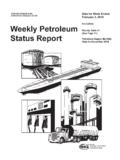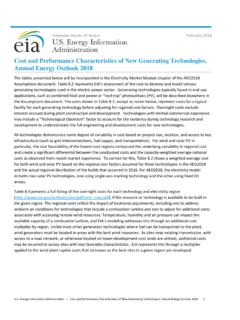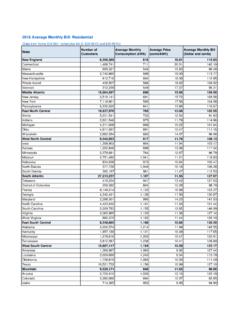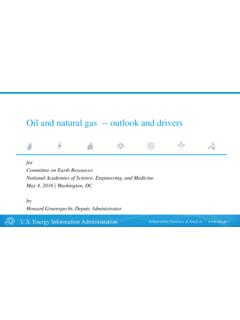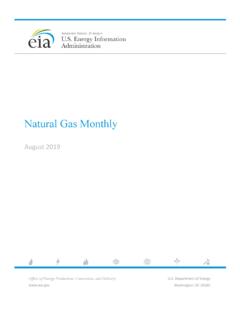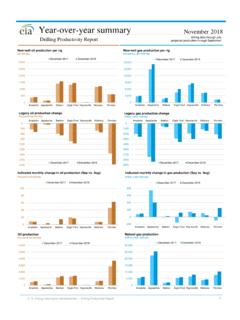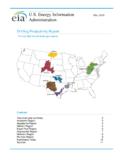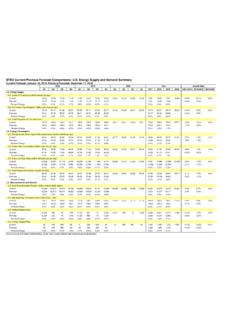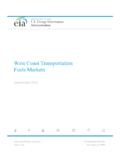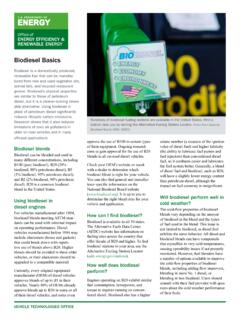Transcription of Transportation sector energy consumption
1 energy Information Administration | International energy Outlook 2016 Chapter 8 Transportation sector energy consumptionOverviewIn the International energy Outlook 2016 (IEO2016) Reference case, Transportation sector delivered energy consumption increases at an annual average rate of , from 104 quadrillion British thermal units (Btu) in 2012 to 155 quadrillion Btu in 2040. Transportation energy demand growth occurs almost entirely in regions outside of the Organization for Economic Cooperation and Development (non-OECD), with Transportation demand roughly flat in OECD regions largely reflecting different expectations for economic growth in developing regions compared with developed 2012, OECD nations accounted for 55% of the world s total Transportation energy consumption , and the non-OECD nations accounted for 45% (Figure 8-1).
2 In 2020, the OECD and non-OECD shares of world Transportation energy use are projected to be equal. Non-OECD demand for Transportation fuels continues to outpace OECD demand, and in 2040 the non-OECD regions are expected to account for 61% of global Transportation energy consumption . In the non-OECD regions, where 80% of the world s population resides, Transportation energy demand nearly doubles, from 47 quadrillion Btu in 2012 to 94 quadrillion Btu in 2040, with an average annual increase of In several of the non-OECD regions, energy consumption in light duty vehicles accounts for the bulk of the increase in total Transportation energy consumption , as economic growth raises standards of living and, in turn, the demand for personal sector energy consumption by fuelWorldwide, petroleum and other liquid fuels326 are the dominant source of Transportation energy , although their share of total Transportation energy declines over the IEO2016 projection period, from 96% in 2012 to 88% in 2040.
3 World Transportation sector liquid fuels consumption grows by 36 quadrillion Btu in the Reference case projection, with diesel (including biodiesel) showing the largest gain (13 quadrillion Btu), jet fuel consumption increasing by 10 quadrillion Btu, and motor gasoline (including ethanol blends) increasing by 9 quadrillion Btu (Figure 8-2). Motor gasoline remains the largest Transportation fuel, but its share of total Transportation energy consumption declines from 39% in 2012 to 33% in 2040. From 2012 to 2040 the total Transportation market share of diesel fuel (including biodiesel), which is the second-largest Transportation fuel, declines from 36% to 33% and the jet fuel share increases from 12% to 14% in share of natural gas as a Transportation fuel grows from 3% in 2012 to 11% in 2040. In 2012, pipelines accounted for 66% of Transportation sector natural gas use, light-duty vehicles 28%, and buses 4%.
4 As a result of favorable fuel economics, an increasing share of natural gas is used for Transportation modes of travel other than pipelines. A strong increase is projected for the natural gas share of total energy use by large trucks in the Reference case, from 1% in 2012 to 15% in 2040. In addition, 50% of bus energy consumption is projected to be natural gas in 2040, as well as 17% of freight rail, 7% of light-duty vehicles, and 6% of domestic marine remains a minor fuel for the world s Transportation energy use, although its importance in passenger rail Transportation remains high: in 2040, electricity will account for 40% of total passenger rail energy consumption . The electricity share of total 326 Other liquid fuels include natural gas plant liquids, biofuels, gas-to-liquids, and 8-1. Delivered Transportation energy consumption by country grouping, 2012 40 (quadrillion Btu)030609012015018020102015202020252030 20352040 DieselNatural gasJet fuelMotor gasolineResidual fuel oilElectricityOther liquidsFigure 8-2.
5 World Transportation sector delivered energy consumption by energy source, 2010 40 (quadrillion Btu) energy Information Administration | International energy Outlook 2016128 Transportation sector energy consumptionlight-duty vehicle energy consumption grows to 1% in 2040 in the Reference case, as increasing sales of new plug-in electric vehicles penetrate the total light-duty Transportation sector energy consumptionThe OECD as a whole does not contribute to the worldwide growth in Transportation fuels consumption in the IEO2016 Reference case. OECD Transportation energy consumption patterns are already well established with slow economic and population growth rates and vehicle efficiency improvements, Transportation energy use for the region as a whole does not increase over the 2012 40 projection period (see Motor vehicle fuel economy and emissions standards by country, below).
6 Almost no increase in Transportation energy consumption is projected for the nations in the OECD Americas, as continued fuel economy improvements offset growth in vehicle miles traveled. In Japan, an aging and declining population results in lower Transportation energy use, dropping by an average of , with Japan s Transportation energy consumption falling from quadrillion Btu in 2012 to quadrillion Btu in 2040. Most of the decline in Japan s Transportation fuel use is for light-duty vehicles, with smaller decreases projected for freight trucks. The largest growth in OECD Transportation energy use is projected for the Mexico/Chile region. In combination, delivered Transportation energy use increases by from 2012 to 2040 (Figure 8-3) compared to for the OECD as a vehicle fuel economy and emissions standards by countryNine countries and regions, which together account for 75% of global fuel consumption by light-duty vehicles, have adopted mandatory or voluntary standards for increasing fuel economy and reducing greenhouse gas (GHG) emissions.
7 The intent and structure of the policies vary widely around the world. Because fuel economy and GHG emissions policies have large effects on fuel consumption , vehicle standards are among the most important components of future demand for liquid area of difference is the metric specified in the standard. Some standards focus on reducing GHG or carbon dioxide (CO2) emissions, some focus on improving fuel economy (or reducing fuel consumption ), and others focus on combinations of the two objectives. The European Union (EU) and India have standards that specifically aim to reduce CO2 emissions. Canada s standard includes restrictions on all GHG emissions. Brazil and Japan have standards that aim to increase fuel economy, requiring light-duty vehicles to achieve specific miles-per-gallon ratings. China s standard requires light-duty vehicles to reduce fuel consumption per mile traveled.
8 The United States and Mexico have both fuel economy and GHG standards, and manufacturers must satisfy both. South Korea s light-duty vehicle manufacturers can choose to meet either a fuel economy or a GHG emissions standard. In practice, however, the different metrics are related: improvements in fuel economy reduce CO2 emissions, and CO2 emissions are a subset of GHG addition, there are structural differences among the various vehicle standards. The United States, Canada, and Mexico have footprint-based corporate average fuel economy (CAFE) standards, which set GHG emissions targets (in Canada) or GHG emissions and fuel economy targets (in the United States and Mexico) based on vehicle footprint, calculated as wheelbase multiplied by average track width. The overall target for a specific manufacturer is determined by averaging the targets for the footprints of all the vehicles the manufacturer produces.
9 Brazil, the EU, India, and South Korea have weight-based corporate average standards, which are similar to footprint-based standards but based on vehicle weight. China has a combination standard based on both vehicle weight class and corporate average fuel economy, which is more stringent than the weight-based corporate average standard alone; light-duty vehicle manufacturers in China must meet fuel consumption standards for each weight class, as well as an overall corporate average fuel consumption standard. Japan has a corporate average standard based on weight class, which requires each light-duty vehicle to meet the standard for its weight class rather than an overall standard for the economy and emissions standards typically are applied to the vehicles that a company sells in a given country, rather than to all the vehicles it produces in a given country.
10 For instance, vehicles sold in Europe are required to meet European standards, and those sold in Japan are required to meet Japanese standards. As more countries adopt light-duty vehicle standards, differences among them are likely to persist because of variations in policy goals and consumer preferences across countries. Still, given the global nature of light-duty vehicle manufacturing, fuel economy is likely to increase for all new vehicles, and GHG emissions per mile traveled are likely to < < StatesOECD EuropeSouth KoreaAustralia/New ZealandMexico/ChileFigure 8-3. Annual average growth in delivered Transportation energy consumption by OECD region, 2012 40 (percent per year) energy Information Administration | International energy Outlook 2016 Transportation sector energy consumptionNon-OECD Transportation sector energy consumptionVirtually all (94%) of the projected growth in world Transportation energy use occurs in the developing non-OECD economies, where strong economic growth leads to rising standards of living that translate to demand for personal travel and freight transport to meet growing consumer demand for goods in non-OECD AsiaMuch of the growth in non-OECD (and world) Transportation energy use occurs in the emerging economies of non-OECD Asia.
